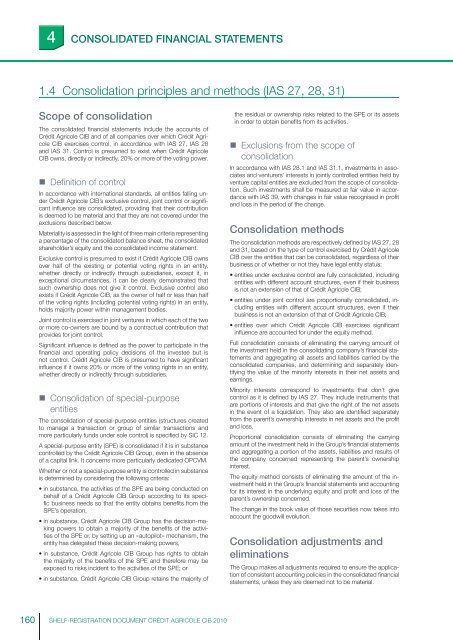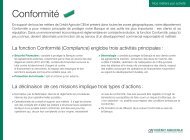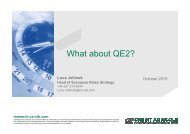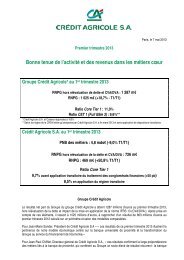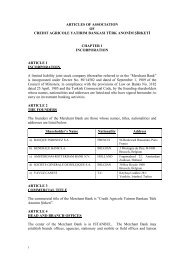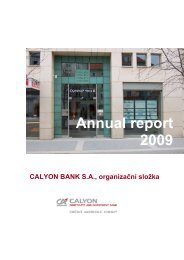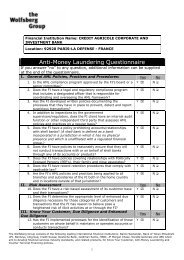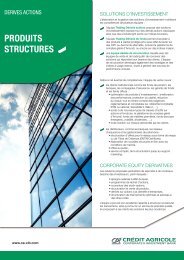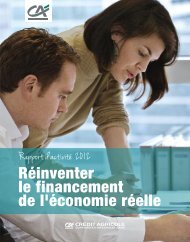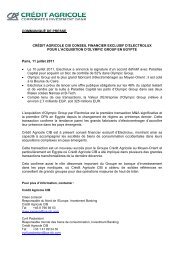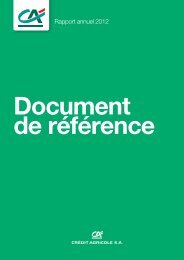ourexpertise - Crédit Agricole CIB
ourexpertise - Crédit Agricole CIB
ourexpertise - Crédit Agricole CIB
Create successful ePaper yourself
Turn your PDF publications into a flip-book with our unique Google optimized e-Paper software.
4CONSOLIDATED FINANCIAL STATEMENTS1.4 Consolidation principles and methods (IAS 27, 28, 31)Scope of consolidationThe consolidated fi nancial statements include the accounts of<strong>Crédit</strong> <strong>Agricole</strong> <strong>CIB</strong> and of all companies over which <strong>Crédit</strong> <strong>Agricole</strong><strong>CIB</strong> exercises control, in accordance with IAS 27, IAS 28and IAS 31. Control is presumed to exist when <strong>Crédit</strong> <strong>Agricole</strong><strong>CIB</strong> owns, directly or indirectly, 20% or more of the voting power.• Defi nition of controlIn accordance with international standards, all entities falling under<strong>Crédit</strong> <strong>Agricole</strong> <strong>CIB</strong>’s exclusive control, joint control or signifi -cant infl uence are consolidated, providing that their contributionis deemed to be material and that they are not covered under theexclusions described below.Materiality is assessed in the light of three main criteria representinga percentage of the consolidated balance sheet, the consolidatedshareholder’s equity and the consolidated income statement.Exclusive control is presumed to exist if <strong>Crédit</strong> <strong>Agricole</strong> <strong>CIB</strong> ownsover half of the existing or potential voting rights in an entity,whether directly or indirectly through subsidiaries, except if, inexceptional circumstances, it can be clearly demonstrated thatsuch ownership does not give it control. Exclusive control alsoexists if <strong>Crédit</strong> <strong>Agricole</strong> <strong>CIB</strong>, as the owner of half or less than halfof the voting rights (including potential voting rights) in an entity,holds majority power within management bodies.Joint control is exercised in joint ventures in which each of the twoor more co-owners are bound by a contractual contribution thatprovides for joint control.Signifi cant infl uence is defi ned as the power to participate in thefi nancial and operating policy decisions of the investee but isnot control. <strong>Crédit</strong> <strong>Agricole</strong> <strong>CIB</strong> is presumed to have signifi cantinfl uence if it owns 20% or more of the voting rights in an entity,whether directly or indirectly through subsidiaries.• Consolidation of special-purposeentitiesThe consolidation of special-purpose entities (structures createdto manage a transaction or group of similar transactions andmore particularly funds under sole control) is specifi ed by SIC 12.A special-purpose entity (SPE) is consolidated if it is in substancecontrolled by the <strong>Crédit</strong> <strong>Agricole</strong> <strong>CIB</strong> Group, even in the absenceof a capital link. It concerns more particularly dedicated OPCVM.Whether or not a special-purpose entity is controlled in substanceis determined by considering the following criteria:• in substance, the activities of the SPE are being conducted onbehalf of a <strong>Crédit</strong> <strong>Agricole</strong> <strong>CIB</strong> Group according to its specific business needs so that the entity obtains benefi ts from theSPE’s operation,• in substance, <strong>Crédit</strong> <strong>Agricole</strong> <strong>CIB</strong> Group has the decision-makingpowers to obtain a majority of the benefi ts of the activitiesof the SPE or, by setting up an « autopilot » mechanism, theentity has delegated these decision-making powers,• in substance, <strong>Crédit</strong> <strong>Agricole</strong> <strong>CIB</strong> Group has rights to obtainthe majority of the benefi ts of the SPE and therefore may beexposed to risks incident to the activities of the SPE; or• in substance, <strong>Crédit</strong> <strong>Agricole</strong> <strong>CIB</strong> Group retains the majority ofthe residual or ownership risks related to the SPE or its assetsin order to obtain benefi ts from its activities.• Exclusions from the scope ofconsolidationIn accordance with IAS 28.1 and IAS 31.1, investments in associatesand venturers’ interests in jointly controlled entities held byventure capital entities are excluded from the scope of consolidation.Such investments shall be measured at fair value in accordancewith IAS 39, with changes in fair value recognised in profi tand loss in the period of the change.Consolidation methodsThe consolidation methods are respectively defi ned by IAS 27, 28and 31, based on the type of control exercised by <strong>Crédit</strong> <strong>Agricole</strong><strong>CIB</strong> over the entities that can be consolidated, regardless of theirbusiness or of whether or not they have legal entity status:• entities under exclusive control are fully consolidated, includingentities with different account structures, even if their businessis not an extension of that of <strong>Crédit</strong> <strong>Agricole</strong> <strong>CIB</strong>;• entities under joint control are proportionally consolidated, includingentities with different account structures, even if theirbusiness is not an extension of that of <strong>Crédit</strong> <strong>Agricole</strong> <strong>CIB</strong>;• entities over which <strong>Crédit</strong> <strong>Agricole</strong> <strong>CIB</strong> exercises signifi cantinfl uence are accounted for under the equity method.Full consolidation consists of eliminating the carrying amount ofthe investment held in the consolidating company’s fi nancial statementsand aggregating all assets and liabilities carried by theconsolidated companies, and determining and separately identifyingthe value of the minority interests in their net assets andearnings.Minority interests correspond to investments that don’t givecontrol as it is defi ned by IAS 27. They include instruments thatare portions of interests and that give the right of the net assetsin the event of a liquidation. They also are identifi ed separatelyfrom the parent’s ownership interests in net assets and the profi tand loss.Proportional consolidation consists of eliminating the carryingamount of the investment held in the Group’s fi nancial statementsand aggregating a portion of the assets, liabilities and results ofthe company concerned representing the parent’s ownershipinterest.The equity method consists of eliminating the amount of the investmentheld in the Group’s fi nancial statements and accountingfor its interest in the underlying equity and profi t and loss of theparent’s ownership concerned.The change in the book value of those securities now takes intoaccount the goodwill evolution.Consolidation adjustments andeliminationsThe Group makes all adjustments required to ensure the applicationof consistent accounting policies in the consolidated fi nancialstatements, unless they are deemed not to be material.160SHELF-REGISTRATION DOCUMENT CRÉDIT AGRICOLE <strong>CIB</strong> 2010


